Статьи журнала - International Journal of Computer Network and Information Security
Все статьи: 1066
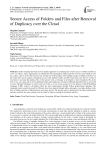
Secure Access of Folders and Files after Removal of Duplicacy over the Cloud
Статья научная
Cloud computing is an emerging concept that makes better use of a large number of distributed resources. The most significant issue that affects the cloud computing environment is resource provisioning. Better performance in the shortest amount of time is an important goal in resource provisioning. Create the best solution for dynamically provisioning resources in the shortest time possible. This paper aims to perform resource provisioning with an optimal performance solution in the shortest time. Hybridization of two Meta-heuristics techniques, such as HSMOSA (Hybrid Spider Monkey Optimization with Simulated Annealing), is proposed in resource provisioning for cloud environment. Finds the global and local value using Spider Monkey Optimization's (SMO) social behavior and then utilizes Simulated Annealing (SA) to search around the global value in each iteration. As a result, the proposed approach aids in enhancing their chances of improving their position. The CloudSimPlus Simulator is used to test the proposed approach. The fitness value, execution time, throughput, mean, and standard deviation of the proposed method were calculated over various tasks and execution iterations. These performance metrics are compared with the PSO-SA algorithm. Simulation results validate the better working of the proposed HSMOSA algorithm with minimum time compared to the PSO-SA algorithm.
Бесплатно
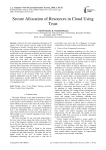
Secure Allocation of Resources in Cloud Using Trust
Статья научная
Cloud is the recent emerging technology in all aspects. The basic concern with the usage of this Cloud Technology is security. Security poses a major drawback with data storage, resource utilization, virtualization, etc. In the highly competitive environment the assurances are insufficient for the customers to identify the trust worthy cloud service providers. As a result all the entities in cloud and cloud computing environment should be trusted by each other and the entities that have communication should have valid trust on each other. Trust being the profound component in any network has attracted many researchers for research in various ways. The models developed so far are platform dependent and are not valid for heterogeneous platforms. An efficient model which can be ported on any platform is the current research trend in the research world. Our model is platform independent and also helps in calculating trust while migrating to another platform. The result shows that the proposed model is much more efficient in terms of computation time.
Бесплатно
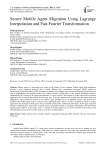
Secure Mobile Agent Migration Using Lagrange Interpolation and Fast Fourier Transformation
Статья научная
Mobile agent is a processing unit works on the behalf of host computer. Mobile agent with intelligence provides a new computing prototype that is totally different from conventional prototype. Mobile agents are automatically itinerating from one host Computer to another host computer and execute assigned task on the behalf of user in heterogeneous environment under own control. Because mobile agents roam around distributed networks automatically, the security of the agents and platforms is a major concern. The number of mobile agents-based software applications has increased dramatically over the past year. It has also enhanced the security risks associated with such applications. Most protection systems in the mobile agent paradigm focus on platform security and provide few guidelines for mobile agent security, which is still a challenging topic. There is a risk to information carries by mobile agents from the malicious mobile agents who can modify and steal the confidential information. In this paper proposed multilevel authentication framework of mobile agents and platform based on Lagrange interpolation and fast Fourier transformation (LIFFT). In this frame work ‘n’ number of mobile agent have two level of security first level key used authentication and second level of key used for execution of mobile agents.
Бесплатно
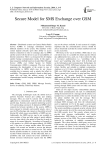
Secure Model for SMS Exchange over GSM
Статья научная
Distributed systems use General Packet Radio Service (GPRS) to exchange information between different members of the system. The members of the system depend critically upon their ability to access internet connection in order to exchange data via GPRS and the system will shut down in case of unavailability of Internet connection. There is a strong need for developing another backup communication media. In this paper a data transaction method based on encoded Short Message Service (SMS) over Global System for Mobile Communication (GSM) is proposed. This new method guarantees the functionality of the system in case of inaccessibility to GPRS which may be not always available due to measures such as attacks that affect its availability. The proposed method is based on third party agent who can keep the address secrecy of both communicators besides keeping confidentiality, integrity and availability.
Бесплатно
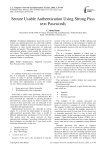
Secure Usable Authentication Using Strong Pass text Passwords
Статья научная
Traditional alphanumeric passwords used for remote user authentication does not offer both usability and security. Graphical passwords were proposed as an alternative to these textual passwords for improving usability and security. This paper proposes a remote user authentication scheme, which extends the existing pass text scheme. The usability and security of the proposed scheme is analyzed. Using Morea tool the Usability of the proposed scheme is investigated.
Бесплатно

Secure and Fast Chaos based Encryption System using Digital Logic Circuit
Статья научная
Chaotic system based message encryption system for wired and wireless networks broadly used in computer engineering, communication and network security, such as robotic systems, encryption, synchronization and genetic network. The main motive for developing the chaos based cryptosystem is to attain encryption with several compensation over the conventional encryption algorithms such as high security, speed, complexity, cost and quality assurance. These challenges encourage the researchers to develop novel chaos based data encryption techniques with digital logics dealing with encryption of messages for fast and secure communication networks. This effort provides a modified version of traditional data encryption algorithms to provide good quality and performance in a secure communication network environment. A cryptology technique is widely used in network security during communication. An avalanche effect is the attractive property of cryptography in which two different keys produce different cipher text for the same data information and also some Important properties related to chaotic systems are sensitivity to initial condition and nonlinearity, which makes two similar or slightly different keys to generate completely different cipher text to produce confusion. It has been proposed a novel fast & secure encryption Technique which uses the chaotic map function to generate the different multiple keys and shows that negligible difference in parameters of chaotic function generate completely different keys as well as cipher text. Cryptanalysis of the proposed algorithm shows the strength and security of algorithm and keys.
Бесплатно
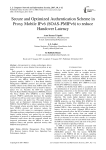
Статья научная
Advancement in wireless technologies allows mobile devices to access Internet from anywhere at any time. Each network is identified by unique IP address. Mobile IP allows a mobile node to change its network without changing IP address. Internet Engineering Task Force (IETF) has suggested several mobility management protocols such MIPv6, HMIPv6, PMIPv6 etc. for perpetual mobility. MIPv6 is a Host-Based Mobility Management (HBMM) protocol and provides global mobility solution to the mobile node. MIPv6 suffers from basic mobility related problems such as handover latency, packet loss etc. Recently the IETF has suggested Network-Based Mobility Management (NBMM) protocol. The Proxy Mobile IPv6 (PMIPv6) is first NBMM protocol. PMIPv6 significantly decreases the signaling overhead, but still has some issues related to the security, handover latency and packet loss. This paper proposes Secure and an Optimized Authentication Scheme in PMIPv6 (SOAS-PMIPv6) to reduce signaling overhead. The proposed scheme provides higher security than the basic PMIPv6 protocol and moreover reduces the signaling cost with respect to contemporary protocols. This paper performs comprehensive analysis on handover latency, packet delivery cost, packet loss etc. and the performance of protocols is mathematically investigated. Numerical result shows that the proposed scheme has improved performance than the MIPv6 in terms of handover latency and provides optimized security than PMIPv6 based protocols.
Бесплатно
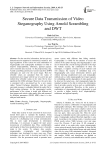
Secure data transmission of video steganography using Arnold scrambling and DWT
Статья научная
For the sensitive information, the best privacy demand must be supported in commercial, technical and legal regulations. In this system we used combination of steganography and cryptography techniques in order to improve imperceptibility, robustness, payload capacity and to transmit data securely. As the preprocessing step, Arnold scrambling and discrete wavelet transform (DWT) techniques are used over the secret image. Then the referable values are calculated from the values of transformed secret image with the use of a secret key and embed these referable values in the video file by least significant bit (LSB) technique. Moreover, the secret key is encrypted with a pre-shared key by a new stream cipher Twisted Exchange Algorithm. And the result encrypted message is embedded behind the audio file by Parity coding technique. As the experimental results, performance of the system is tested with different real time images and various video quality files and measured by different parameters (PSNR, MSE), then it is also analyzed with attacks.
Бесплатно
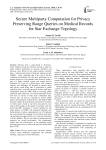
Статья научная
Moving from a paper-based to electronic-based medical records has become recently a target for many medical institutions to increase efficiency and decrease costs. However, this makes patient's sensitive data – collected and stored in electronic medical records (EMRs) – more vulnerable and at the risk of privacy violations and breaches. For this sake, institutions try to protect the privacy of its patients' data. However, being a part of a bigger medical system may require that an institution be a part of a global query, such situation imposes new challenges for hospitals to preserve their data privacy while being able to participate in global analytical queries with other hospitals. Secure multi-party computation protocols (SMC) help in executing global analytical queries between a set of distrustful data owners who have no desire to share their confidential data, however they all need to cooperate to answer global queries about patients' medical history. The bulk of SMC protocols targets the ring topology execution environment in which query results at one node are passed to next node in the topology. In this paper, we propose a privacy preserving SMC technique to execute equality-test and range queries on EMRs. Our proposed technique uses bucketization to reduce computational cost. We replaced the conventional ring topology by start where each party can exchange messages directly over a private connection with the mediator. This too can improve management and improves the overall performance. Our experimental results show the effectiveness of our technique which provides better privacy without the need for trusted third party (TTP).
Бесплатно

Secure video compression and integration technique for data transmission
Статья научная
This paper approaches security application for digital image and video processing. The techniques involve H.264 Video Compression, Elliptical Curve Cryptography Encryption followed by Image Interleaving and last by Pixel Integration to generate integrated multi-video. The user can choose any of the videos among the several integrated videos displayed with a unique security key for each video. With the secure key assigned for each video input, the original video is displayed by decrypting it from multiple videos.
Бесплатно
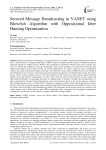
Статья научная
Emergency Message broadcasting is an important process in VANET. Security and reliable transmission are the two major concerns in message broadcasting. VANET is open to unauthorized nodes, hackers, misbehaving vehicles, malicious attackers etc without security. Without valid confirmation of authorized vehicles, these types of attacks may occur. To enhance the reliability in message broadcasting, some existing techniques are used. They transmit the data without much delay but they didn’t provide any trusted authentication. So hackers, malicious nodes, unauthorized vehicles may easily interrupt the emergency messages. Also Brute force attack, Man in Middle attack are not identified and eliminated. In this research, a trust based secured broadcasting mechanism is developed which ensures the metrics such as security, privacy, integrity, trust etc. The major intension of this research is to reduce latency and provide high reliable, secure and efficient communication over the vehicles. The data such as vehicle position, location, speed, and other traffic information’s are generated and stored in a separate table. A network is created with varying densities. A path is generated for message broadcasting between source and destination based on the specific gateway estimated. Here, Optimal Wireless Access in Vanet (OWAV) Protocol is employed to gather vehicle related information to reduce the delay. Blowfish encryption algorithm along with Oppositional Deer Hunting Optimization (ODHO) is used to store the trusted vehicles location to avoid unauthorized tracking. The performance of the proposed research is analyzed with various metrics such as Packet delivery ratio (PDR), transmission delay, encryption time, throughput, computational overhead etc. The efficiency of the research is compared with other existing methods.
Бесплатно
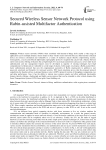
Secured Wireless Sensor Network Protocol using Rabin-assisted Multifactor Authentication
Статья научная
Wireless sensor networks (WSNs) when combined with Internet-of-things (IoT) enable a wide range of applications across multiple domains. Sensor nodes in these wireless sensor networks like any other Internet-connected device are resource constrained and vulnerable to a variety of malicious attacks thereby compromising security. Consequently, a secure and efficient lightweight cryptographic protocol is required that can provide a balance between end-to-end security offering all features but yet lightweight. For secure data transmission and access, newer multi-factor authentication and key management features must be developed as majority of existing techniques have high computational overheads and are vulnerable to a wide range of attacks. In this paper, we propose a Rabin-assisted three-factor authentication protocol that uses the computational asymmetry of Rabin cryptosystem in addition to user password, smartcard and biometric for increased security. NS2 based simulation proves that the proposed protocol outperforms the baseline ad-hoc on-demand distance vector (AODV) protocol in terms of throughput, computation cost, and delay performance. Also, it has the ability to tolerate most common attacks and offers additional functionality features thereby offering a lightweight and highly secure protocol that can be extended to other critical domains like Smart Transportation Systems (STS), Smart grids, Smart buildings etc.
Бесплатно

Securing Voice Communications Using Audio Steganography
Статья научная
Although authentication of users of digital voice-based systems has been addressed by much research and many commercially available products, there are very few that perform well in terms of both usability and security in the audio domain. In addition, the use of voice biometrics has been shown to have limitations and relatively poor performance when compared to other authentication methods. We propose using audio steganography as a method of placing authentication key material into sound, such that an authentication factor can be achieved within an audio channel to supplement other methods, thus providing a multi factor authentication opportunity that retains the usability associated with voice channels. In this research we outline the challenges and threats to audio and voice-based systems in the form of an original threat model focusing on audio and voice-based systems, we outline a novel architectural model that utilises audio steganography to mitigate the threats in various authentication scenarios and finally, we conduct experimentation into hiding authentication materials into an audible sound. The experimentation focused on creating and testing a new steganographic technique which is robust to noise, resilient to steganalysis and has sufficient capacity to hold cryptographic material such as a 2048 bit RSA key in a short audio music clip of just a few seconds achieving a signal to noise ratio of over 70 dB in some scenarios. The method developed was seen to be very robust using digital transmission which has applications beyond this research. With acoustic transmission, despite the progress demonstrated in this research some challenges remain to ensure the approach achieves its full potential in noisy real-world applications and therefore the future research direction required is outlined and discussed.
Бесплатно
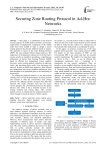
Securing Zone Routing Protocol in Ad-Hoc Networks
Статья научная
This paper is a contribution in the field of security analysis on mobile ad-hoc networks, and security requirements of applications. Limitations of the mobile nodes have been studied in order to design a secure routing protocol that thwarts different kinds of attacks. Our approach is based on the Zone Routing Protocol (ZRP); the most popular hybrid routing protocol. The importance of the proposed solution lies in the fact that it ensures security as needed by providing a comprehensive architecture of Secure Zone Routing Protocol (SZRP) based on efficient key management, secure neighbor discovery, secure routing packets, detection of malicious nodes, and preventing these nodes from destroying the network. In order to fulfill these objectives, both efficient key management and secure neighbor mechanisms have been designed to be performed prior to the functioning of the protocol. To validate the proposed solution, we use the network simulator NS-2 to test the performance of secure protocol and compare it with the conventional zone routing protocol over different number of factors that affect the network. Our results evidently show that our secure version paragons the conventional protocol in the packet delivery ratio while it has a tolerable increase in the routing overhead and average delay. Also, security analysis proves in details that the proposed protocol is robust enough to thwart all classes of ad-hoc attacks.
Бесплатно
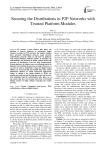
Securing the Distributions in P2P Networks with Trusted Platform Modules
Статья научная
We present a novel solution that allows one platform to securely distribute or redistribute digital contents to another in P2P networks. The solution includes three protocols (distribution protocol, usage protocol, redistribution protocol) which are all based on platforms with Trusted Platform Modules (TPMs). It maintains the confidentiality and freshness of digital contents during the processes of distribution. Given an ideal (tamper-proof) trusted platform, the solution can even withstand attacks by dishonest users during the processes of usage. Moreover, it can also be used to redistribute n-time-use digital content offline, so it is more flexible and scalable than other related distribution solutions to enable widespread deployment. Lastly, by adding a few simple features to TPMs, our solution can easily prevent the malicious sender and receiver from colluding when the redistribution takes place, so we can ensure that they can not gain more than a previously defined amount of rights without contacting the content provider.
Бесплатно
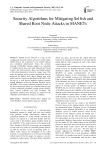
Security Algorithms for Mitigating Selfish and Shared Root Node Attacks in MANETs
Статья научная
Mobile ad hoc network is a type of self configurable, dynamic wireless network in which all the mobile devices are connected to one another without any centralised infrastructure. Since, the network topology of MANETs changes rapidly. It is vulnerable to routing attacks than any other infrastructure based wireless and wired networks. Hence, providing security to this infrastructure-less network is a major issue. This paper investigates on the security mechanisms that are proposed for Selfish node attack, Shared root node attack and the Control packet attack in MANETs with the aid of a well known multicast routing protocol namely Multicast Ad hoc On Demand Distance Vector (MAODV). The security solutions proposed for each of the above mentioned attacks are evaluated with the help of three evaluation parameters namely packet delivery ratio, control overhead and total overhead. The algorithmic solutions thus obtained are analysed in the simulation environment by using ns-2 simulator.
Бесплатно

Security Analysis and Implementation of an Improved Cch2 Proxy Multi-Signature Scheme
Статья научная
Many of the signature schemes are proposed in which the t out of n threshold schemes are deployed; but they still lack the property of security. In this paper, we have discussed implementation of improved CCH1 and improved CCH2 proxy multi-signature scheme based on elliptic curve cryptosystem. We have represented time complexity, space complexity and computational overhead of improved CCH1 and CCH2 proxy multi-signature schemes. We have presented cryptanalysis of improved CCH2 proxy multi-signature scheme and showed that improved CCH2 scheme is suffered from various attacks i.e. forgery attack and framing attack.
Бесплатно
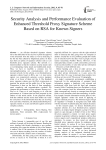
Статья научная
An efficient threshold signature scheme solves the difficulties of the receiver to proof the approval of the document from the sender as well as detecting if the file has been altered by illegitimate parties. In these days there are plenty of signature schemes such as (t,n) threshold proxy signature scheme. The network is a shared medium so that the weakness security attacks such as eavesdropping, replay attack and modification attack. Thus, we have to establish a common key for encrypting/decrypting our communications over an insecure network. In this scheme, a (t,n) threshold proxy signature scheme based on RSA, any t or more proxy signers can cooperatively generate a proxy signature while t-1 or fewer of them can't do it. The threshold proxy signature scheme uses the RSA cryptosystem to generate the private and the public key of the signers. Comparison is done on the basis of time complexity, space complexity and communication overhead. We compare the performance of four schemes: Hwang et al., Wen et al., Geng et al. and Fengying et al. with the performance of a scheme that has been proposed by the authors of this article earlier. In the proposed scheme, both the combiner and the secret share holder can verify the correctness of the information that they are receiving from each other. Therefore, the enhanced threshold proxy signature scheme is secure and efficient against notorious conspiracy attacks.
Бесплатно
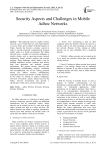
Security Aspects and Challenges in Mobile Adhoc Networks
Статья научная
The traditional notion of a Adhoc wireless network is one in which there are a few Base Stations or Access Points and a number of Mobile Stations or Nodes. Security has become a primary concern in order to provide protected communication between mobile nodes in a hostile environment. The Adhoc networks pose a number of nontrivial challenges to security design, such as open peer-to-peer network architecture, shared wireless medium and network topology. These challenges clearly make a case for building multifence security solutions that achieve both road protection and desirable network performance. The general security objectives like authentication, confidentiality, integrity, availability and non-repudiation, the ad hoc routing protocols should also address location confidentiality, cooperation fairness and absence of traffic diversion. In this paper we attempt to analyze Challenges, Overview of Security, attacks, threats faced by the Adhoc network environment and provide a classification of the various security mechanisms.
Бесплатно
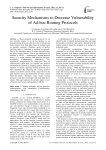
Security Mechanisms to Decrease Vulnerability of Ad-hoc Routing Protocols
Статья научная
Many proposed routing protocols for ad hoc networks operate in an ad hoc fashion, as on demand routing protocols often have low overhead and faster reaction time than other types of routing based on periodic protocols. Dynamic nature of ad-hoc networks leads to challenges in securing the network. Due to the vulnerable nature of ad-hoc networks there are many security threats. One of the solutions to the problem is ARAN – Authenticated routing protocol which is a secure protocol and provides Integrity, Availability, Confidentiality, Authenticity, Non repudiation, Authorization & Anonymity. But an authenticated selfish node can interfere this protocol and disturb the network by dropping packets. However varieties of attacks targeting routing protocols have been identified. By attacking, the routing protocol attacker can absorb network traffic, inject them in the path between source and destination and thus control 0network traffic. Therefore many secure routing protocols have been developed that deal with these attacks. This paper analyzes the security aspects of one commonly used secure routing protocol ARAN.
Бесплатно

